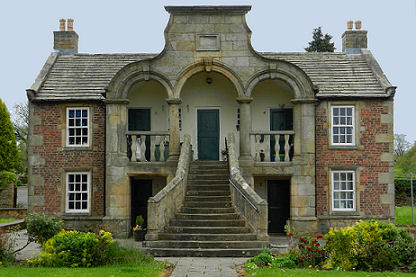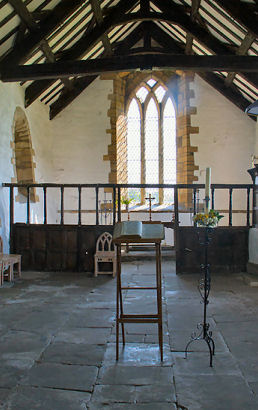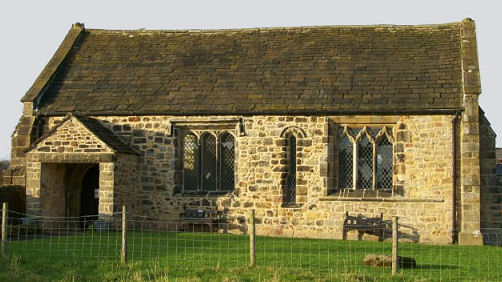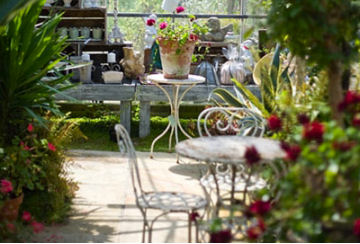Stydd
OS Grid ref:- SD 653359
 The hamlet of Stydd is situated on the north eastern edge of the village of Ribchester in Lancashire's beautiful Ribble Valley. An ancient settlement, the first recorded reference to Stydd occurs in 1276 (otherwise spelt as Styd, Stede, Steed, Stidd or Stid). The name means 'place' or 'farm' an 'estate in land'. The hamlet boasts three notable buildings:- St Saviour's Church, a set of almshouses and the Church of Saint Peter and Saint Paul.
The hamlet of Stydd is situated on the north eastern edge of the village of Ribchester in Lancashire's beautiful Ribble Valley. An ancient settlement, the first recorded reference to Stydd occurs in 1276 (otherwise spelt as Styd, Stede, Steed, Stidd or Stid). The name means 'place' or 'farm' an 'estate in land'. The hamlet boasts three notable buildings:- St Saviour's Church, a set of almshouses and the Church of Saint Peter and Saint Paul.
Stydd Almshouses (pictured left) stand near the entrance to Saint Peter and Paul's Church. The building was constructed in 1728 under the terms of John Shireburne's will. Shireburne, of Stoneyhurst, then owner of the Stydd Manor estate, instructed that he wished to found and build "a good almshouse on his estate at Stydd for 5 poor persons to live seperately therein". The resulting building is an unusual amalgam of styles.
 The building has a prominent central flight of steps, sweeping up to a striking, almost baroque, arcade on the first floor, with a curved stone parapet above. The architectural historian Pevsner described it as 'very curious and very engaging' and the building survives unchaged to this day.
The building has a prominent central flight of steps, sweeping up to a striking, almost baroque, arcade on the first floor, with a curved stone parapet above. The architectural historian Pevsner described it as 'very curious and very engaging' and the building survives unchaged to this day.
There is evidence of a community at Stydd from the twelfth century and there has been a place of worship on the site since no later than the thirteenth century, possibly since 1190. The earliest documentary records of a religious foundation at Stydd are in undated deeds from the middle of the twelfth century, which refer to 'the hospital of St Saviour, under [the] Long Ridge and the Master and brethren also serving God there'. St. Saviour's Church, (pictured left and interior right) which stands in a field close to Stydd Manor Farm, is the only one surviving of a group of buildings acquired by the Knights Hospitallers in the late thirteenth century. The interior of the building measures 46 feet 6 inches (14.17 metres) by 20 feet 6 inches (6.25 metres).
 The church has a stone flagged floor and plastered and whitewashed walls. There is a piscina at the east end of the south wall, with a trefoil head, but without a bowl. There is no architectural division between the nave and the sanctuary, although the floor of the latter is slightly raised.
The church has a stone flagged floor and plastered and whitewashed walls. There is a piscina at the east end of the south wall, with a trefoil head, but without a bowl. There is no architectural division between the nave and the sanctuary, although the floor of the latter is slightly raised.
There is an oak panelled screen between the two that dates from the seventeenth or eighteenth century. The oak pulpit stands against the south wall; it is octagonal with square panels and sits on a stone base and has a set of stone steps. On the south wall there are two straight-headed windows, each of three lights, dating from the fifteenth century, both are reported to have been taken from St Wilfrid's church at Ribchester and installed at St.Saviour's in the seventeenth century.
The octagonal gritstone font is Late Perpendicular in style and has well-preserved carvings of shields, it is thought to date from the sixteenth century. There are also stone monuments to Sir Adam Clitheroe and his wife Lady Alicia, dating from 1350 or thereabouts and to Francis Petre of Showley Hall in Clayton-le-Dale, a Roman Catholic Bishop who died in 1775. An extensive restoration was carried out on the building in 1925. In the churchyard stands the pedestal of an ancient cross.
 The church occupies the site of much older buildings, possibly Roman in origin. In 1916 an excavation by staff and pupils from Stonyhurst College unearthed the foundations of a building with rounded bays, like an apse, which they believed to be a Mithraeum - a temple to the Roman cult of Mithras - or possibly an early Christian church dating from the Roman period. The excavations discovered extensive charring among the footings which they unearthed, indicating that the building had at some point been extensively damaged by fire. Accidental fire was an ever-present threat in both Roman and medieval times but it has been suggested that part of the site could have been destroyed during a Scottish raids into central Lancashire, Robert the Bruce is known to have pillaged and laid waste to the area in the 1320s.
The church occupies the site of much older buildings, possibly Roman in origin. In 1916 an excavation by staff and pupils from Stonyhurst College unearthed the foundations of a building with rounded bays, like an apse, which they believed to be a Mithraeum - a temple to the Roman cult of Mithras - or possibly an early Christian church dating from the Roman period. The excavations discovered extensive charring among the footings which they unearthed, indicating that the building had at some point been extensively damaged by fire. Accidental fire was an ever-present threat in both Roman and medieval times but it has been suggested that part of the site could have been destroyed during a Scottish raids into central Lancashire, Robert the Bruce is known to have pillaged and laid waste to the area in the 1320s.
The Roman Catholic Church of Saint Peter and Saint Paul's is an early 'barn church' built to look like a barn to disguise its function as a place of worship. . The church was built in 1789 and extended in 1877. The site was carefully chosen for at that time it was still illegal for Catholics to have public places of worship.
Stydd Gardens (pictured right) specialises in the English gardening tradition, Stydd Gardens is a tranquil oasis and seedbed of inspiration. Set amidst the gardens is a collection of creative and imaginative businesses. From an exciting garden design company, a real garden nursery where most of the plants are grown on site and specializing in old fashioned roses, to a delightful cafe and tea room housed in our exquisite glass-house and an innovative and bespoke wine company. Stydd Nursery stocks a good range of, mainly hardy, garden plants.
Nearby Places of Interest
Ribchester- unique village, situated in the Ribble Valley in Lancashire.
Whalley Abbey- founded by Henry de Lacy, third Earl of Lincoln on the 4th April 1296.
Lancaster Castle founded in the tenth century
Ashton Memorial in Williamson Park, Lancaster was commissioned by James Williamson, Baron Ashton as a tribute to his second wife, Jenny and was built between 1907 and 1909.
